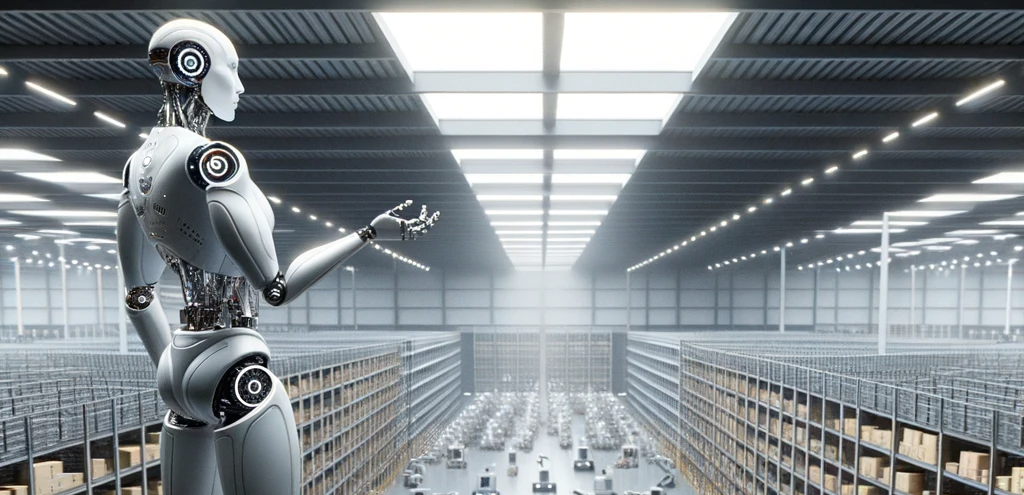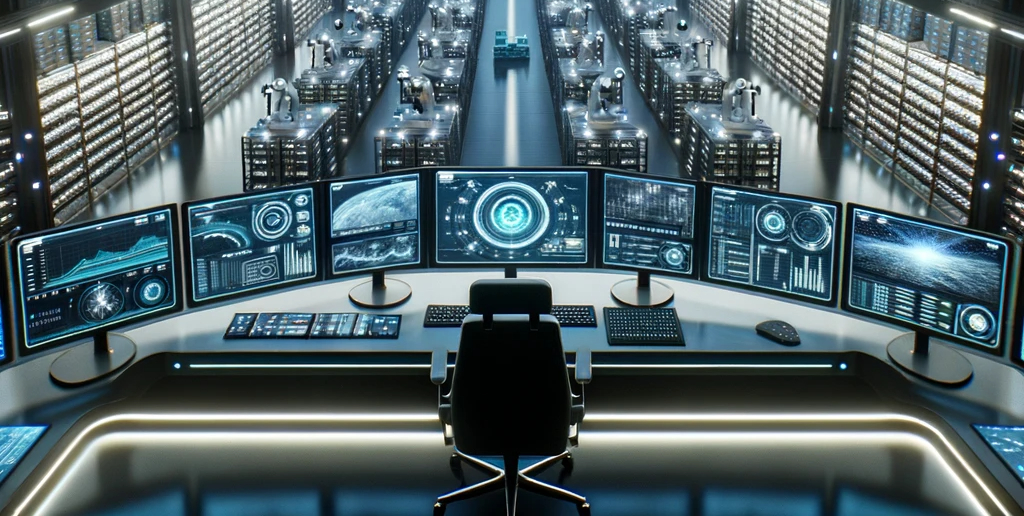How The Landscape of Warehouse Investing Is Shifting Due to AI powered Robots?
To know about the major shift in warehouse management from humans to robots, one needs to know about what warehouse management is and how it works. Warehouse management refers to the storage of inventory in a giant store effectively. It’s not an easy task and near to hard nut to crack.
In the beginning, it was handled manually by keeping records, and the inventory was managed by a huge force. In the last decade, records management has shifted to artificial intelligence-based software like POS, which keeps a high number of inventory records in seconds. The addition and removal of inventory items have now become easy to do.

The Perfect Delivery Entails Perfect Warehouse Management
What Is Warehouse Management?
Warehouse management involves the processes that comprise the day to day activities of a warehouse. It mainly includes managing and organizing the warehouse area, labour scheduling, sorting inventory, and completion of orders. Apparently, the workings of the warehouse and its operations are invisible to the customers. It is just like the drama you play on the screen, but the real efforts are behind the screen. It plays an important role in picking the order to deliver. This whole process entails many operations in all aspects. The aim of our warehouse is to maximize productivity and lower costs.
The warehouse management process involves some crucial steps. It includes receiving, put away, storage, picking, packing, and shipping in ascending manner. Warehouse management mainly involves inventory management, material handling, processing and packaging, supply chain, and demand planning. The next stage is the optimization of warehouse management, which involves well managed warehouse processes and operations. This crucial process can be made easy by intruding artificial intelligence and robots. AI-based software can make the processing easy and cost effective.

AI & Robotic Transition Revolutionize Traditional Warehouse into Automotive Warehouse
Inculcation of Robots and AI Into Warehouse Management
In the modern era, Artificial intelligence interconnects technology to processes and provides accuracy and speed that encompasses human capabilities. It unlocks several possibilities for the warehouse management. AI refers to the combination of machine learning, neural networks, deep learning, vast vision, and speech and visual recognition. The technology doesn’t end here with only the assistance of AI but with the Robo culture. Robotic machines are now employed in warehouses for the management of warehouses. The main purpose behind this is to boost the efficiency of the warehouse within minimum time and less errors as Amazon Warehouses have already proven.
This technological advancement is reshaping the warehouse culture to its peak. It is normalized in most of the regions and gradually spreads to the other regions. It not only benefits the current situation of warehouses but can be used to predict the future endeavours of the possible advancements in this field.
Purpose of Investment in Warehouse Management
The purpose behind the investment in the warehouse is to increase profits. The warehouse has been a vast real estate in which investors can easily invest for more payback due to internal and external factors. In this era of digitization, you can see the topmost business of this century is retail and E-commerce. Shopping is becoming a daily activity of the people. Markets and enterprises are expanding in this aspect, and more space is needed for warehouses. So, it is surprisingly important to make an investment in the warehouse. It has expanded not only on the high demand of the customers but also due to its being the most profitable sector of the market.
In the Covid-19 pandemic situation, you saw a paradigm shift towards online shopping. Almost the whole retail system has been transformed into online shopping. This pandemic produced a vast range of entrepreneurs, due to which more warehouses are needed and for which more space is needed to build warehouses. So, the investors should cooperate with the entrepreneurs in this regard. It has been observed and predicted that the warehouse market profit will increase by 2x at the end of 2025 with automation in warehouse management.

Benefits of Investing in Robots and AI for Warehouse Management
- Cost-Effective Sales
The sheer benefit of investing in robots and AI for warehouse management is to generate cost-effective benefits and sales. Now the question arises that new technology is more expensive in maintenance than the old one. Then how can it be cost-effective? The answer is that the labor cost has been minimized due to the transition of humans to robots. The maintenance of robots or robotic machines is computerized now, so just the installation and upgradation of the system are needed. Moreover, the accuracy and speed of the work in bulk also improve sales, which exhales remarkable benefits to investors and entrepreneurs.
The inculcation of robots doesn’t mean that the human force lost its importance or they are not capable of doing the management of a warehouse. It lessens and shares the burden of hectic man force burden. They can easily do repetitive tasks, complicated jobs, progressing, programming, developing, and monitoring the warehouse’s activities, which adds more value to the warehouse business. It has been observed that warehouses spend a dominant amount of cash daily, like to cover up the area accidents and employee well-being, to fulfil the shortcomings like carbon emissions. - Lower Risk Ratio and Increase Safety
Human machines are strong and powerful, but besides this, they are delicate and have the probability of damage. So, the human labour force needs rest and accommodation to rest so that they can work efficiently. Human employees face different types of hazards and risks on warehouse floors that damage the health and efficiency of workers. The unnecessary movements and heavy loads affect the health and efficacy of the labour force. They need leave and compensation for their work. They are emotional in nature (that alters from time to time) and have families to run. These are the factors that make a difference in the efficiency of robots, which can’t be ignored when it comes to making a comparison between humans and robots.
On the other hand, robots have more margin to work efficiently. With them, the chances of warehouse daily accidents and losses are less. Moreover, they are not emotional and don’t have families, so they can’t be depressed and experience emotional imbalances due to which they work easily. They don’t need sick leave, pay, or compensation. They only need maintenance with a precise ratio with one-time allocated maintenance and investment rather than to spend daily incurrences. The human labour force can’t be customized, but robots can be according to the workload and requirements. - Lessen Errors and Wastage
As we know, “to err is the human.” The nature of humans can’t be changed. The employees in the warehouse make many errors in daily activities, and many inventory items go to waste. On the other side, some perishables have to be disposed of when they get expire; for this activity, robots are programmed with AI so that this activity can be done effortlessly. Robots are revolutionizing warehouse management by lessening errors and wastage. Here are some of the ways robots are helping to improve warehouse efficiency:
Accuracy: Robots are incredibly accurate, which helps to reduce errors in picking, packing, and shipping. They can scan barcodes and QR codes with precision, and they can identify and pick items from shelves quickly and accurately. This helps to reduce the number of misplaced items and incorrect shipments, which can save businesses time and money.
Efficiency: Robots can work much faster than humans, which can help to improve warehouse efficiency. They can also work 24/7, which means that warehouses can operate longer hours and process more orders. This can help businesses to meet customer demand and reduce lead times.
Space utilization: Robots can help businesses to maximize their warehouse space. They can stack items higher and more densely than humans, and they can access narrow aisles and other hard-to-reach areas. This can help businesses to store more inventory in a smaller space.
Safety: Robots can help to improve safety in warehouses. They can lift and move heavy items without risk of injury to workers. They can also be used to perform dangerous tasks, such as working with hazardous materials. - Improve Productivity
Overall, robots can help to improve productivity in warehouse management by automating repetitive tasks, improving accuracy, increasing speed, maximizing space utilization, and reducing labour costs.
Here are some specific examples of how robots are being used to improve productivity in warehouse management today:
1. Autonomous Mobile Robots (AMRs) are being used to transport goods and pallets around warehouses. AMRs can navigate autonomously, and they can be programmed to optimize their routes and avoid obstacles.
2. Goods-to-Person Picking Systems use robots to bring products to pickers rather than the other way around. This can help to reduce pick times and improve accuracy.
3. Case-Picking Robots can be used to pick and pack cases of goods. This can be a very efficient way to pick large orders.
4. Pallet Handling Robots can be used to load and unload pallets of goods, as well as to stack and move pallets around the warehouse. This can help to reduce manual labor and improve safety.
As the technology continues to develop, robots are becoming more sophisticated and capable. This means that they can perform a wider range of tasks in warehouses, and they are able to do so with greater efficiency and accuracy. As a result, robots are playing an increasingly important role in warehouse management. - Modified Customer Support
One of the most significant ways that robots are modifying customer support in warehouse management is by automating tasks that were previously performed by human workers. This can free up human workers to focus on more complex tasks, such as providing customer support. For example, robots can be used to pick and pack orders, move inventory around the warehouse, and load and unload trucks. This can help to improve the efficiency and accuracy of order fulfilment, which can lead to improved customer satisfaction. This can help to reduce customer anxiety and frustration.
Robots can also be used to provide more personalized customer support. For example, robots can be used to collect feedback from customers about their experience and use that feedback to improve customer service. Additionally, robots can be used to provide customers with personalized recommendations for products and services.
Here are some specific examples of how robots are being used to modify customer support in warehouse management:
Chatbots: Chatbots are computer programs that can simulate conversation with humans. They are often used to provide customer support on websites and in messaging apps.
Voice Assistants: In the context of warehouse management, voice assistants can be used to provide customer support by answering customer questions about their orders, tracking the status of their orders, and providing other customer support services.
Robotic Process Automation (RPA): RPA is a technology that allows businesses to automate tasks that are typically performed by humans. In the context of warehouse management, RPA can be used to automate tasks such as order processing, inventory management, and customer support.

Summary
First, robots and AI are making warehouses more efficient and productive. This is leading to lower costs for warehouse operators, which is making warehouses more attractive to investors.
Second, robots and AI are enabling new warehouse designs and layouts. For example, robots can be used to operate in narrow aisles and high-density storage areas, which can free up more space for inventory.
Third, robots and AI are making it possible to automate more tasks in the warehouse. It reduces the need for manual labour, saving warehouse operators a significant amount of money.
Fourth, robots and AI are improving inventory management. For example, robots can be used to track inventory in real-time and to identify and pick up orders quickly and accurately. It can help warehouse operators to reduce inventory costs and to improve customer service.
Finally, robots and AI are making warehouses more sustainable. For example, robots can be used to reduce energy consumption and to reduce waste. This can make warehouses more attractive to investors who are looking for sustainable investments.
Overall, robots and AI are making warehouses more efficient, productive, and sustainable. This is making warehouses more attractive to investors, and it is shifting the landscape of warehouse investing.
